Welcome to our comprehensive guide on successful seed starting! Whether you’re a beginner or have some experience, this article will provide you with expert tips and techniques to help you unlock the secrets of seed starting. By following our advice, you’ll be well on your way to growing healthy and thriving plants from seeds. Let’s dive in!

Choosing the Right Seeds
When it comes to seed starting, choosing the right seeds is crucial. Opt for high-quality seeds from reputable suppliers. Look for seeds that are labeled as organic, non-GMO, and have a high germination rate. Pay attention to the specific needs of each plant variety, such as light requirements, temperature preferences, and growth habits.
Preparing the Soil
Before you start sowing your seeds, it’s important to prepare the soil properly. Use a well-draining seed starting mix that is light and fluffy. Avoid using garden soil, as it can be too heavy and may contain weed seeds or pathogens.
Fill your seed trays or pots with the seed starting mix, leaving a small gap at the top. Moisten the mix thoroughly, but make sure it’s not too wet. Excess moisture can lead to fungal diseases and damping off.
Sowing the Seeds
Now that you have the right seeds and prepared soil, it’s time to sow your seeds. Follow these steps for successful seed sowing:
- Read the seed packet instructions for the recommended sowing depth and spacing.
- Make small holes or furrows in the soil using your finger or a pencil.
- Place the seeds in the holes or furrows, ensuring they are evenly spaced.
- Gently cover the seeds with soil, following the recommended sowing depth.
- Lightly press down on the soil to ensure good seed-to-soil contact.
Providing Optimal Conditions
Seeds require specific conditions to germinate successfully. Here are some key factors to consider:
Temperature
Most seeds germinate best within a specific temperature range. Some prefer cooler temperatures, while others require warmth. Refer to the seed packet instructions for the ideal germination temperature. Utilize a seed starting heat mat or a warm location in your home to provide the necessary warmth.
Light
Light is crucial for seed germination and early seedling growth. Place your seed trays in a location that receives bright, indirect sunlight. If natural light is insufficient, you can use fluorescent grow lights or LED grow lights. Position the lights close to the seedlings to prevent them from becoming leggy.
Watering
Proper watering is essential for seed germination and seedling development. Avoid overwatering, as it can lead to damping off and root rot. Water the soil gently using a spray bottle or a watering can with a fine rose. Keep the soil consistently moist, but not saturated.
Transplanting Seedlings
Once your seedlings have developed a few sets of true leaves, it’s time to transplant them into individual pots or containers. Follow these steps for successful transplanting:
- Prepare the new pots or containers with fresh potting soil.
- Gently loosen the seedlings from the seed tray, being careful not to damage the delicate roots.
- Dig a small hole in the new potting soil and place the seedling, ensuring it’s at the same depth as it was in the seed tray.
- Fill the hole with soil and lightly press down to secure the seedling.
Hardening Off and Planting Out
Before permanently planting your seedlings outdoors, they need to be hardened off. This process allows them to acclimate to outdoor conditions gradually. Follow these steps:
- Start by placing your seedlings in a sheltered, shady spot outdoors for a few hours each day.
- Gradually increase the exposure to sunlight and outdoor elements over the course of a week.
- After a week of hardening off, your seedlings will be ready for planting in their final location.
Conclusion
Congratulations! You’ve now unlocked the secrets of successful seed starting. By following these expert tips and techniques, you’ll be able to grow healthy and thriving plants from seeds. Remember to choose the right seeds, prepare the soil, provide optimal conditions, and transplant and harden off your seedlings properly. Happy gardening!
